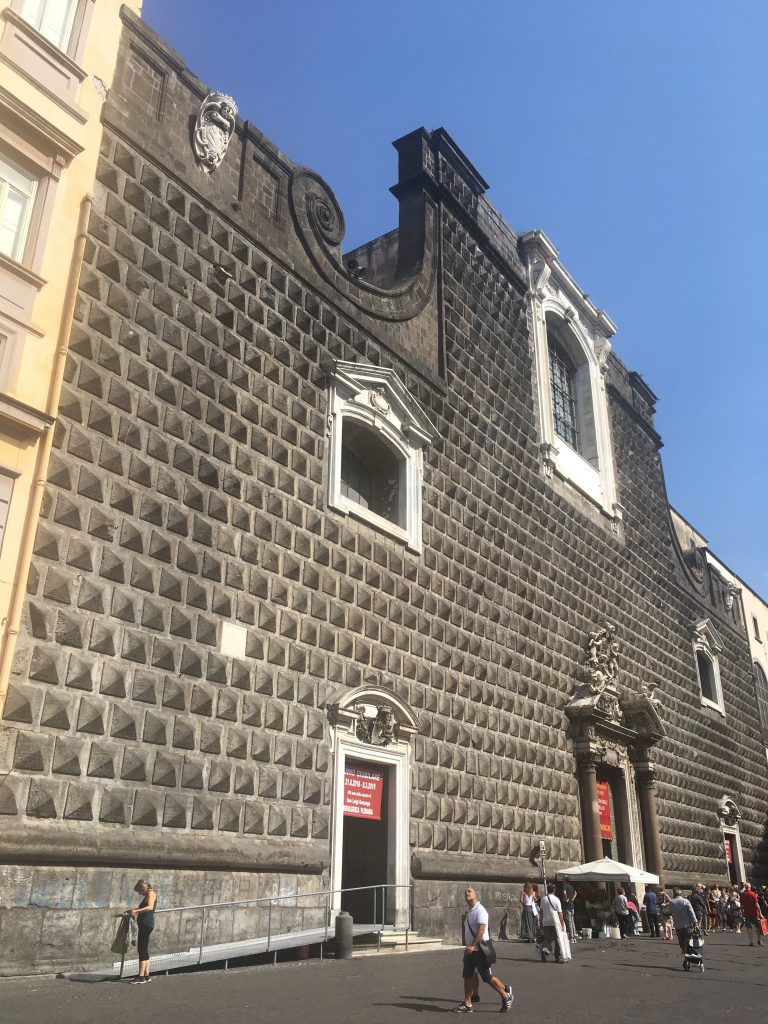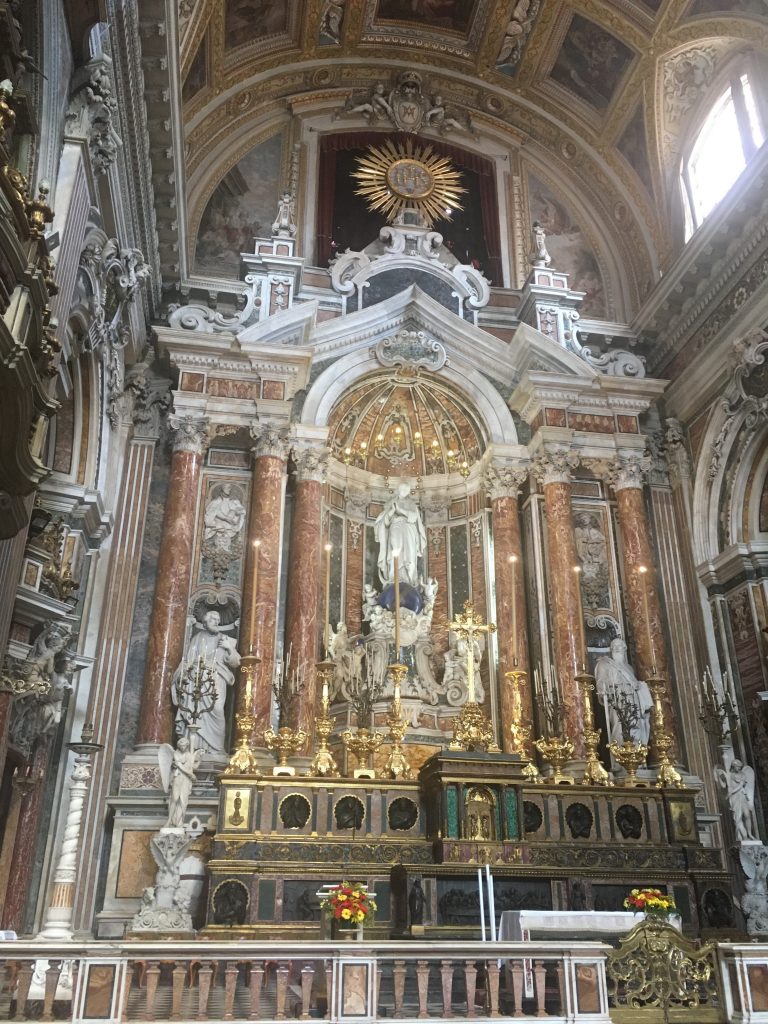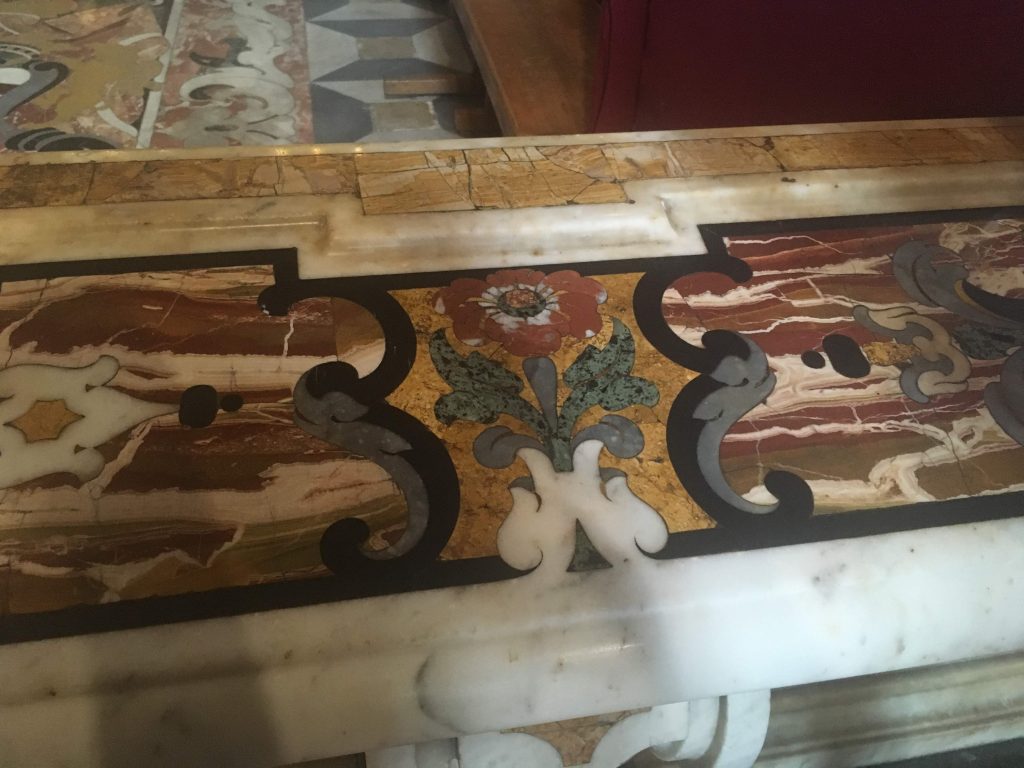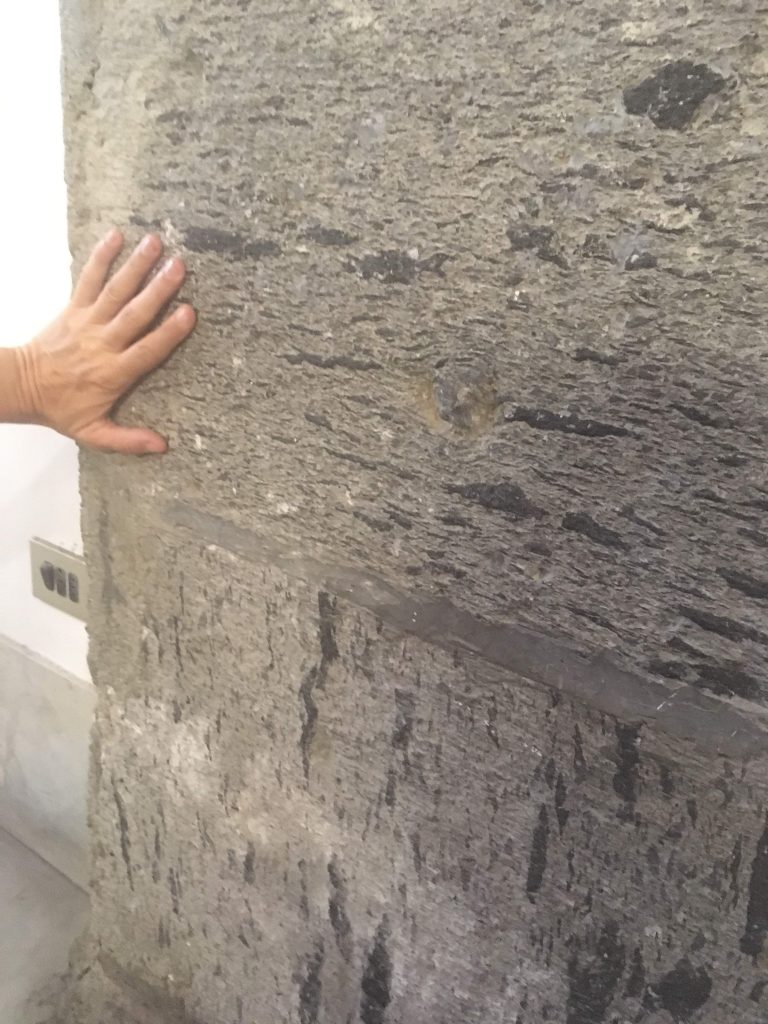24 September 2018
For great Italian geology, go to church
Posted by Jessica Ball
I’m finally, finally back from a long summer of work travel, which I was lucky enough to cap off with my first Cities On Volcanoes 10 conference in Naples, Italy. The conference was great (more on that later), and after my post-conference field trip (also more on that later), I spent an extra weekend in Naples. There’s so much to see in the city – so much gelato to eat – but one thing I learned was that if you want to sample the local geology, you could do worse than visit a church.
I’m not particularly religious at this point in my life, but I find that I can still appreciate the craft that went into creating churches even if I don’t agree that it was the best way to spend all of that money. Italy in particular is full of fabulous examples of the stonemason’s art, and one was just around the corner from my bed-and-breakfast.
Beth Bartel and I took to calling this the “spiky church”, but it’s actually the Chiesa del Gesù Nuovo, a 15th-century palazzo built for Roberto Sanseverino, the Prince of Salerno. It was confiscated from his family and sold to the Jesuits in the 1580s, then passed to the Fransicans when the Jesuits were expelled from Naples in 1767, and back to the Jesuits in 1821. (Whew!) Now it’s dedicated to St. Joseph Moscati, a doctor and biochemistry teacher who worked there and died in 1927. (He is actually still there, since his body is preserved in an ossuary below one of the altars. Italians have a different attitude toward death when it comes to saints…)
But while the inside of the church is stunning, the stones caught my eye particularly. Italian churches are full of Italian marble, in all colors and configurations, and it’s pretty stunning. Also, visually overwhelming!
But for me, the real star of the show was hidden off to the side, in the hallway leading to Saint Moscati’s old quarters. Fiamme!
Fiamme, appropriately enough, is the Italian word for “flames”, and it’s used to describe lenses of flattened material in volcaniclastic rocks that have undergone compaction and/or welding. In the case of this church, though I don’t know the originating formation, it’s pretty clear that these little dark babies used to be pumice fragments. There’s a neat mechanical contrast just to the right of Beth’s hand, where a small lithic block is undeformed, but the pumices flanking it have been flattened into little glassy streaks. The pumice just wasn’t strong enough to stand up to the compaction, whereas the lithic block was unaffected.
A little Google searching turned up a likely candidate for the rock: Piperno, a ubiquitous building stone in the historical center of Naples. Quarried from Campi Flegrei, its origins have been debated, but the prevailing theories call it either a welded ash fall or ash flow tuff. Regardless of its formation, it was much in demand during the period when the Aragonese ruled Naples, and as a result the interior and exterior of Gesù Nuovo are made of piperno. The style of the outside of the church is sometimes called “diamond rustication” (bugnato in Italian), where the faces of the stones are shaped into low pyramids rather than smooth, flat surfaces. It’s visually intimidating, but it doesn’t serve any defensive purpose (in fact, it would have made it easier to climb!)
There are two other famous Neapolitan building stones – the piperno, the Neapolitan Yellow Tuff, and the Campanian Ignimbrite. All associated with explosive eruptions, which are one of the major concerns associated with having such a large population living near the active Campi Flegrei Caldera and Vesuvius Volcano. Those were big themes of the meeting, but I’ll save them for another post.
For more on piperno:
- Morra et al. 2010: Urban geology: Relationships between geological setting and architectural heritage of the Neapolitan area, Journal of the Virtual Explorer 36 DOI: 10.3809/jvirtex.2010.00261
- Calcaterra et al. 2005, Piperno from Campi Flegrei: A relevant stone in the historical and monumental heritage of Naples (Italy), Environmental Geology 47(3):341-352 DOI: 10.1007/s00254-004-1156-3






 Jessica Ball is a volcanologist at the U.S. Geological Survey, researching volcanic hydrothermal systems and stability, and doing science communication for the California Volcano Observatory. She previously worked at the Geological Society of America's Washington DC Policy Office, learning about the intersection of Earth science and legislative affairs. Her Mendenhall postdoc and PhD focused on how water affects the stability of volcanoes, and involved both field investigations and numerical modeling applications. Her blogging covers a range of topics, from her experiences in academic geosciences to science outreach and communication to her field and lab work in volcanology.
Jessica Ball is a volcanologist at the U.S. Geological Survey, researching volcanic hydrothermal systems and stability, and doing science communication for the California Volcano Observatory. She previously worked at the Geological Society of America's Washington DC Policy Office, learning about the intersection of Earth science and legislative affairs. Her Mendenhall postdoc and PhD focused on how water affects the stability of volcanoes, and involved both field investigations and numerical modeling applications. Her blogging covers a range of topics, from her experiences in academic geosciences to science outreach and communication to her field and lab work in volcanology.
Awesome post Jessica! My family always find it odd how I rave over the stone work and wood work in the churches and museums. I have more pictures of those than other artwork! Thanks for sharing!
Jessica,
Like you, I can’t keep my eyes and mind off the materials the ancients used in their structure. Very interesting read and thank you.
I was lucky to be stationed in Naples during my Navy career. And visited many churches. After the navy I pursued a career in geology. Now retired, I am planning to revisit many of the places I saw during the 70s and because of your article will be looking at churches in Europe in a different light. Thank you.
I was lucky to have been stationed in Naples during my Navy career. After the Navy, I returned to the states to pursue a degree in geology. Now that I am retired. I plan to revisit many of the places I visited while in Europe. Thanks to your article, I shall be looking at the churches in a different light than I did in the 70s. I appreciate your work. Thank you again.
This is a very gneiss post! You Rock Jessica!
Greatly enjoyed your post about visiting churches in Italy. It reminded me of a field trip we took in my Igneous petrology class as an undergrad to downtown Muncie IN. Prof said no rock hammers allowed! We got a lot of weird looks from the people on the street.
Hello Jessica. Here Dan. I am from Naples, Italy, and I graduated (and spent many years) at the “Chiostro of San Marcellino” in Naples which is known as the “Home of Neapolitan Geologists” and it’s made mostly of piperno columns and the famous so called “fiamme”, flames, inside of it.. we, while being students, had had all the pleasure and the privilege to sit and admire on those piperno made seats in our breaks between a lesson and the following one… Yep there are many reminiscence of a vast use of volcanic building material due to the great abundance around and so are many churches, streets and buildings of the centro storico.. And yes, it is actually exciting, I can understand your sensations.. Thank you for posting this, I am glad you did and glad you had a great time roaming around these geo-beauties, the various churches and the city.
Thanks,
Dan.
Hi Dan! Thanks for writing. It sounds like you had a great time exploring the geology in Naples as well (and for much longer). I’m looking forward to my next visit and seeing more piperno!
[…] For great Italian geology, go to church, by Jessica Ball […]